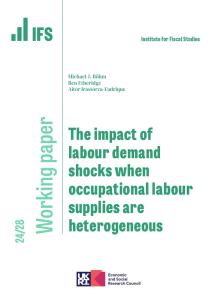The government is considering easing the current restraint on the pay of public sector workers. It had previously announced in 2015 that public sector pay scales would only increase by an average of 1% per year up to and including 2019–20. This briefing note describes the trade-offs faced by the government when deciding how to set public sector pay.
Key findings
- Public pay restraint means that average pre-tax weekly earnings in the public sector in 2016–17 were 4% (£22 per week) lower in real terms than in 2009–10 (and in 2007–08). Mean private sector weekly pay in 2016–17 was 5% lower than in 2007–08.
- Public sector pay grew faster than private sector pay in the aftermath of the recession. Subsequent pay restraint in the public sector reversed that trend, meaning that by 2016–17 the difference between public and private sector pay had returned to its pre-crisis level. Controlling for workers’ characteristics such as education and experience, average pay is quite similar in the public and private sectors.
- Continuing to increase public sector pay scales by only 1% per year in 2018–19 and 2019–20 would likely lead to growth in public pay falling significantly behind growth in private sector pay, exacerbating the emerging recruitment, retention and motivation problems in the public sector. Increasing public sector pay in line with prices or private sector earnings would likely mitigate these problems.
- Workplace pension provision in the public sector remains far more generous, on average, than in the private sector. This is despite automatic enrolment boosting pension coverage among private sector workers. 83% of public sector workers receive an employer contribution to their pension worth 10% or more of their salary, compared with only 11% of private sector workers.
- Compared with private sector pay, public sector pay is lower for highly educated workers than for low-educated workers. Indeed, the pay of lower-educated workers in the public sector is now higher relative to equivalent private sector workers than it was in 2007–08. However, graduates in the public sector have seen their pay fall relative to private sector comparators. Based on the performance of pay, it is among better-paid and higher-educated public sector workers that we might expect greater recruitment and retention issues and a more pressing need for pay increases, though there may well be cases where the converse is true. Public pay is also low relative to private pay in London and the South East and higher than private pay in most other regions.
- The public sector paybill was £181 billion in 2016–17. Therefore even small percentage increases in average pay can lead to significant extra costs for public sector employers. Increasing average public sector pay in line with either prices or private sector earnings would increase the cost of employing the 5.1 million public sector workers by around £6 billion per year by 2019–20. If the Treasury were not to provide extra funds to pay for higher pay, public sector employers would need to make cuts elsewhere. The Treasury could increase spending on departments by increasing taxes, cutting other spending or borrowing more.










